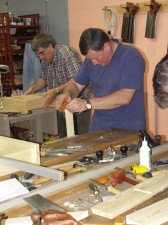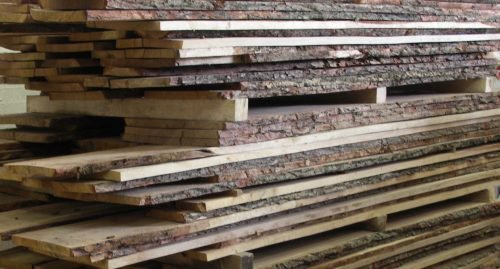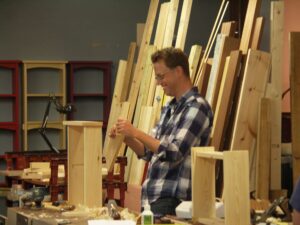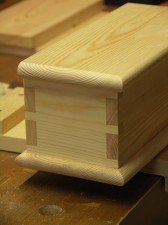My creative workspace #22
Extending my creative workspace
We all have important phases in our lives. Landmarks if you will. I have had them since the beginning of my work life. My first day in the Hillgate, Stockport workshop was one of them. My life is quite different now to then. Instead of being a boy I am an older man and a master craftsman in my own right in my own Penrhyn Castle workshop. I have been for the past 36 years. Back then I had little wisdom, but youth and enthusiasm were on my side. Today I have wisdom and stamina. In my 60s I still work long days and hard. I have much to accomplish before my life is over and one of them is to pass all that I know onto the next generation. Some of that generation are in their 40s while others are in the 20s and 30s. I am inspired by their heartbeat, their raw energy, their challenge. The oak wood and pine inspire me. They wait for my tool’s cut. I wait for the right moment. Inspiration comes with every breath and movement and I shuffle my belongings around to intake the next batch of wood and students at the some time.
It’s an important phase in my life. In addition to my every day woodworking and furniture making, I have resolved to represent my work as a craftsman and the resulting research these past 46 years for others to learn from and I find myself now planning and developing spheres from which to enhance training for other woodworkers around the world. I love to work creatively and launch into new projects. I recently purchased a ton of wonderful European Oak, much of it quartersawn. It’s lovely to have wood in the racks and to be ably to pick out the best for the best parts and use up all secondary grade wood for secondary levels such as drawer backs and bottoms. Soon we will be discussing the unfolding patterns of project planning so hang in there and I will be walking you through all of the stages it takes to get the wood, develop the plans and make the finished piece ready for the customer.
Yesterday my creative workspace was extended. Students came for three days and mastered the basic common dovetail. Not every joint was perfect, but with each corner they perfected their skills and techniques and got used to the tools, sharpening, layout and so much more. They questioned some unconventional methods because newer convention had replaced the old conventions and they had never heard the old conventions. For instance, waterstones have now replaced conventional oilstones to become conventional sharpening stones. Does that mean that old oilstones were useless or didn’t work. No, not really, simply that there was a marketing strategy to give woodworkers something that wore out quickly. Some stones will never be replaced. So it is with techniques and methods, clamps, vises; saws are a better example. But these are issues for serious evaluation and discussion and this is what happens in hands on discussion around my bench in every workshop I do.
Here is Caleb Pendleton from Texas in the USA finishing a project. He’s using techniques he knew nothing of before this weekend. They are now his, as they are 3,500 other students I have worked with over the past 30 years. I’m extending my creative workspace to other households, businesses, regions and countries.
James Schumann made his box and shelf, but much more than that he took steps he had never really experienced before. They will all grow as the progress through the course and one day I hope to see their work evolve into their own designs.







I got home from the 3 day foundation course last night. I have been an enthusiastic amateur woodworker for many years but who would have thought that in 3 days I could learn so much, be inspired to try new projects and have a great time sharing experiences with people who have a passion for working with hand tools.
Hello Sheldon,
Well it certainly was inspring all round. David emailed me too to say how much he enjoyed it. In the longer range we will be progressing to much more advanced levels and much of it will be online too. Please keep checking in and I will look forward to meeting you again soon.
Best regards for now,
Paul
Paul I would like to thank you for providing a very enjoyable learning experience, I would not thought it possible that I would be able to produce two near perfect (In my view) projects using only hand tools.
The castle location, surrounding area, course content and your excellent to teaching would be hard to beat.
I have learnt many new tricks and skills that have moved my modest wood working skills up several notches. The course would be of benefit to the raw beginner and the more experienced wood worker.
Working and socialising with the other course members was also good.
As Arnold Schwarzenegger said "I'll be back"
Best Regards
David
Hello David,
We had a great fun amidst the monstrous learning curve and the radical paradigm shifts on sharpening. If you get chance, try to come to the tool restoration workshop and bring your saws with you. I would encourage anyone to do it because we take the time to dismantle and go over tools so thoroughly there.
I really enjoyed getting to know you and everyone else. It was great!
Best regards,
Paul
Hi Paul
I have now finished off my wall unit all glued up waiting finishing ,What do you recommend , I want it left in the natural wood finish , I know for sure that prior to attending the course last week I could not have produced a project to such a high standard. The box has good dovetail joints on three corners, the joint on the other corner is not so good is there a good way of filling in the joint gaps on that corner
Thanks again
Best Regards
David
Sorry David, got busy. Two types of clear coat finish spring to mind and both are easy to apply. I like shellac in all of its different forms. Here in the UK you can by a quart of clear (bleached) shellac that has all natural pigment bleached out. Shellac is a durable finish that can be applied with a soft cloth pad or a small 1" paint brush. I usea brush called a hake, which artists use and are readily available on line. These brushes leave almost no brush marks. I like shellac because its a no nonsense no clean finish. I dedicate my brush to shellac and allow the brush to harden. Dipping it back into the shellac softens the hardened bristles after about 3-4 minutes. Herein can lie the problem, but I think not. Because alcohol, the solvent that makes the shellac liquid, desolves previous layers, it's not suitable for surfaces where spirit alcohol-based drinks are placed as any leakage or spillage will dissolve the finish. Applying a second coat does that too, if you are slow with the brush. Shellac must be applied directly and without fuss. Place it, pull it, leave it. Quick, simple, effective. It's my favorite finish of all. Three brush coats followed by furniture paste wax does the job. Leave between coats for an hour or so and sand after the first coat. Liberon sells a product called sanding sealer which is a thin cut of shellac that works well for all 3-4 coats. Superfine 0000 steel wool cuts the final surface ready for waxing and 250-grit sandpaper on the first coat takes care of all sanding.
If you want a very durable finish you can use Ronseal's water-based varnish (B&Q). I like the satin finish in clear. Apply in the same way as shellac, with a brush or a rag, but you must wash the brush thoroughly because it will not redissolve with water once dried. I also like this finish for tabletops and any high-wear areas. It dries rapidly on a warm day and three coats can go on in a matter of two hours or less. Use paste wax again for a final sheen but leave steel wooling until the next day.
A trick for both finishes that works well is to wrap the brush in cling film between coats. That stops surface hardening and curing for the course of finishing and means only one time clean up. The shellac brush can be kept wrapped in a thin plastic bag indefinitely. it will eventually harden, after a week or so, but readily dissolves in the shellac. I keep mine wrapped all the time because I use shellac almost every day.
Hi Paul
Did you have a chance to look at my question posted 5 days ago
Best Regards
David
Hi David,
I just added my recommendations to your earlier post.
Best regards for now,
Paul